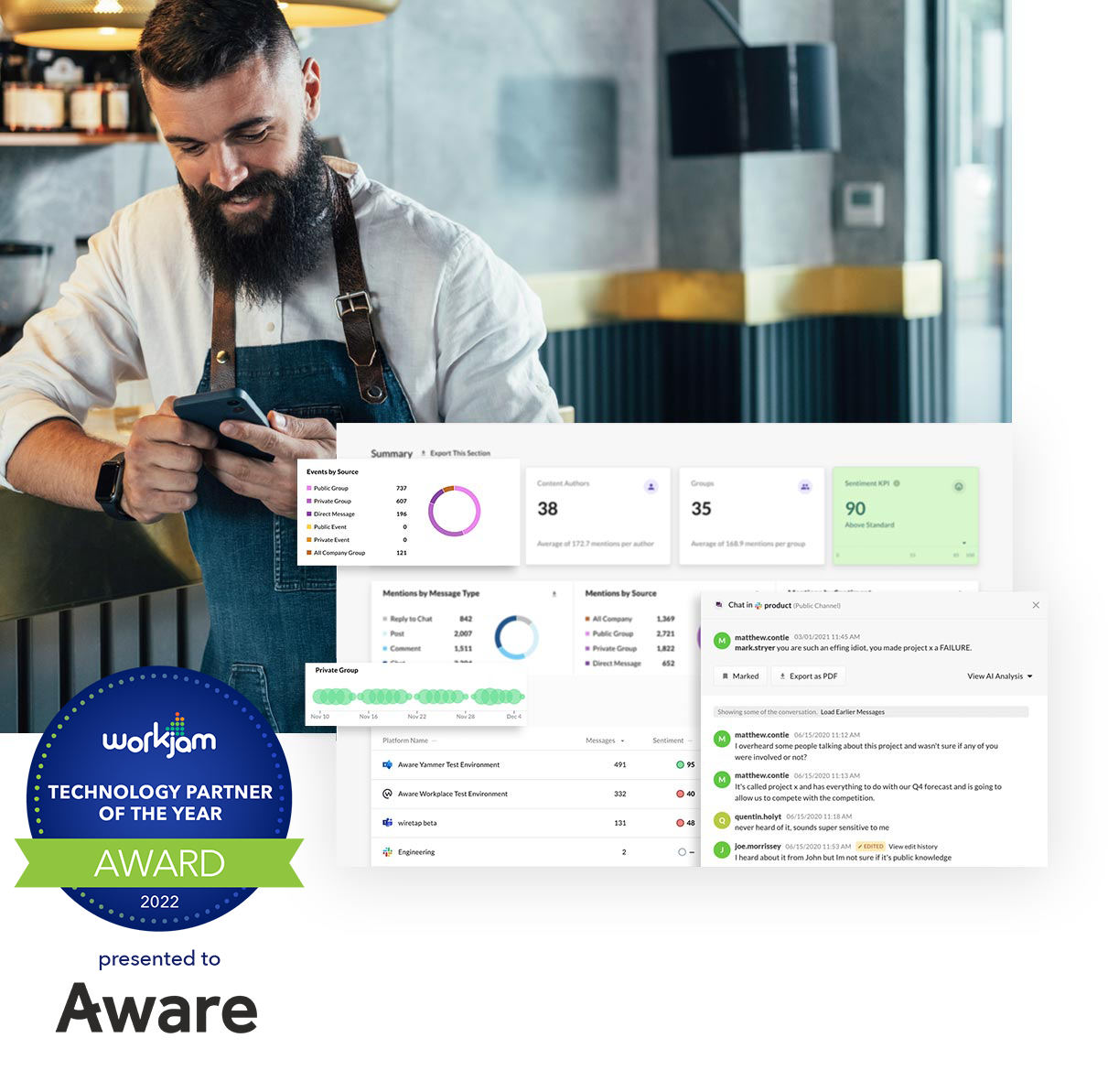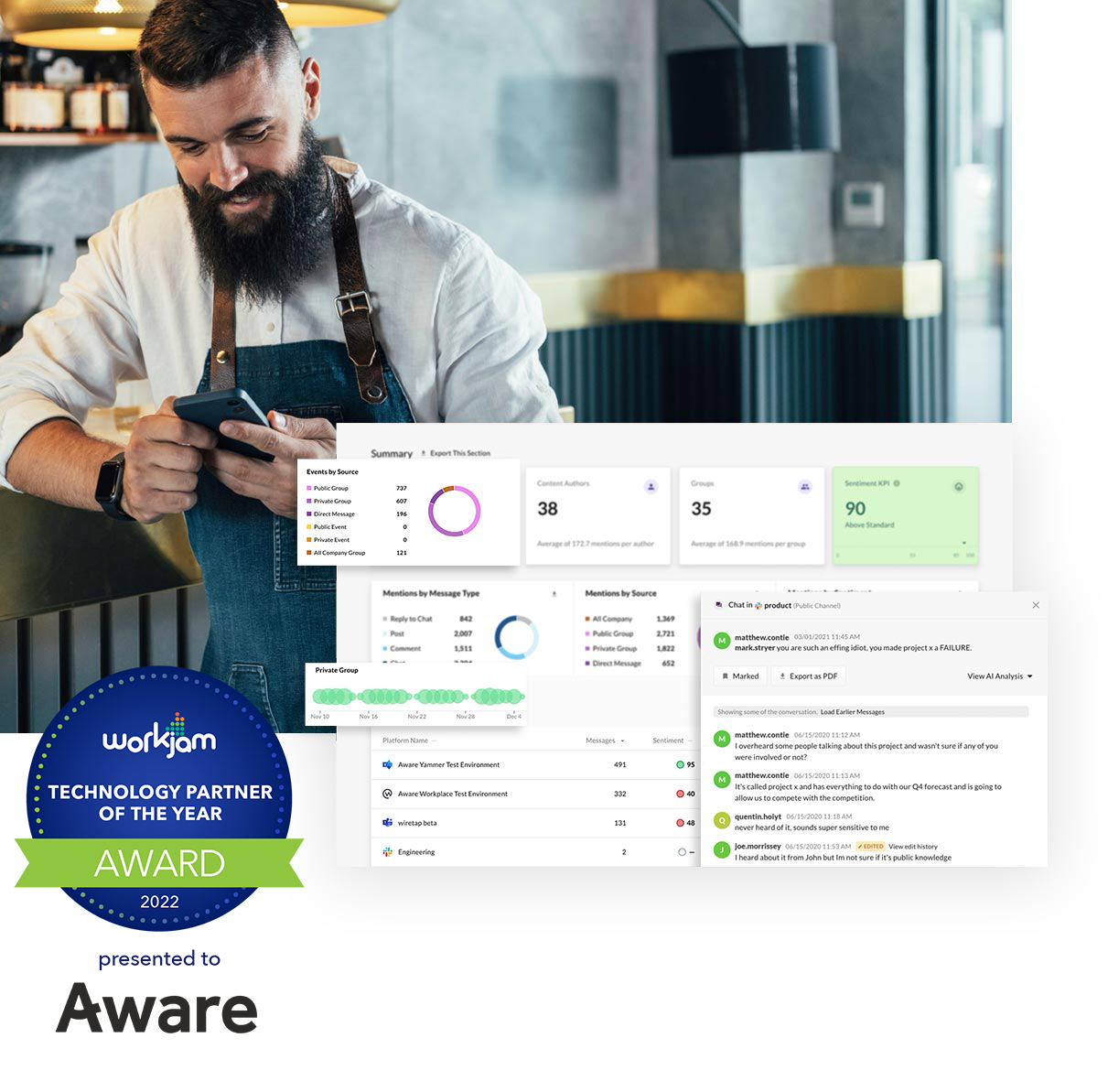Everything You Need to Know about Data Loss Prevention in WorkJam
by Aware
Companies with large numbers of frontline employees can benefit from workforce management tools like WorkJam. While invaluable for streamlining operations, these tools contain contains large amounts of sensitive and confidential information. To safeguard that data, administrators must implement the right DLP solution. This blog explores the DLP measures admins need to take to protect their data in WorkJam.
Contents
- What is WorkJam?
- What is data loss prevention (DLP)?
- 5 data security risks of WorkJam
- What sensitive information does WorkJam hold?
- How can administrators protect sensitive data in WorkJam?
- Mitigating the risk of a data breach from WorkJam
- How does Aware support DLP in WorkJam?

What is WorkJam?
WorkJam is a comprehensive workforce management platform that connects and engages frontline employees, managers, and corporate teams. It offers a unified platform for scheduling, communication, task management, and more. WorkJam empowers organizations to optimize productivity, improve employee engagement, and enhance customer experience by providing a seamless digital workplace environment.
What is data loss prevention (DLP)?
Data loss prevention, or DLP, is the process of securing confidential data from unauthorized access. DLP solutions include internal policies such as password requirements, as well as monitoring software that analyzes keywords, file transfers, and data movement to flag unauthorized activity. Implementing robust DLP controls helps business to maintain trust and protect their assets from malicious actors.

5 data security risks of WorkJam
WorkJam, like any workforce collaboration tool, contains a significant amount of confidential, proprietary, and sensitive data. This data must be proactively protected from unauthorized access or exfiltration. Some of the top concerns for administrators looking to secure their WorkJam environment include:
- Unauthorized Actors: Any time somebody accesses confidential information without permission, the company is at risk of data loss and regulatory noncompliance.
- Insider Threats: Employees or individuals with authorized access to WorkJam can also present a threat to information security if they expose restricted information through negligence or malice.
- Phishing Attacks: These breaches are triggered by fake emails or texts (“smishing”) that prompt users to reveal their WorkJam login credentials or other sensitive information.
- Social Engineering Hacks: Malicious actors can manipulate WorkJam users into granting access or sharing restricted information by using deceptive tactics such as posing as a coworker or authority figure.
- Third-Party Integrations: WorkJam integrates with other third-party applications or services, and vulnerabilities in these integrations can pose security risks. If a third-party service has weak security measures or suffers a breach, it could potentially expose WorkJam data.
By being proactive and vigilant about data security, organizations can mitigate these risks and protect sensitive information within the WorkJam platform.
What sensitive information does WorkJam hold?
As a complete frontline digital workplace, WorkJam holds several types of sensitive information. These include personal identifiable information (PII) such as employee names and contact details. WorkJam also contains financial and payment card industry (PCI) data such as payslips, payment records, and tax documents. In addition, large amounts of proprietary company information and IP, such as training and onboarding guides, company policies and procedures, and discussions regarding new products and initiatives, are all available within WorkJam.
Highly regulated workplaces such as those in the healthcare or financial sectors may also share information within WorkJam that falls under additional compliance requirements, such as HIPAA or FINRA.
When addressing DLP within WorkJam, administrators must consider all types of data they may have to protect, their legal and regulatory obligations, and the value of that data to malicious actors.

How can administrators protect sensitive data in WorkJam?
To protect sensitive information in WorkJam, workspace admins should follow information security best practices. These include internal policy measures such as training employees on how to create strong passwords and to change them regularly. When using WorkJam, admins should consider enabling Single Sign-On (SSO) to further limit password exposure. Additionally, admins can establish role-based access controls (RBAC) to limit visibility of sensitive data to only the people and departments who need access.
In addition to these measures, it’s important to keep all applications and integrations up to date with the latest security patches. Finally, admins should regularly audit their entire digital workplace, including WorkJam, to ensure they are always following the latest data loss prevention best practices.
Mitigating the risk of a data breach from WorkJam
Despite robust security measures, data breaches can still occur in any workplace application, including WorkJam. If a data breach is suspected or confirmed, it’s important to act quickly to mitigate the damage, but there are steps workspace admins can take to proactively reduce thew risk of a data breach happening, and limit exposure if it does.
These steps include establishing retention policies to preserve or purge sensitive data according to company need and using a trusted DLP vendor to identify valuable data, restrict information sharing, and take immediate action to limit potential risk exposures.

How does Aware support DLP in WorkJam?
Aware provides comprehensive data loss prevention measures within WorkJam using proprietary natural language processing (NLP) and AI models that identify infosec risks in real time. Aware’s industry-leading technology gives administrators and leaders a complete, contextual understanding of what is happening within their digital workplace, shining a light into hidden corners where insider threats can hide.
Using Aware, administrators can establish automated workflows to detect sensitive information sharing, such as PII/PCI/PHI, as well as company-specific IP and proprietary information. Additionally, Aware enables admins to satisfy legal and compliance demands with eDiscovery, retention, and centralized governance controls.
Final thoughts
Data loss prevention is crucial when using WorkJam or any other workforce management platform. By understanding the importance of data security and leveraging the DLP features provided by WorkJam, organizations can protect sensitive information from unauthorized access, leakage, or breaches. By adopting best practices, educating employees about data security, and pairing WorkJam with Aware’s trusted DLP integration, businesses can limit their risk exposure and improve their security posture within WorkJam.
Learn more about how Aware enables data protection, compliance, and next-generation frontline insights for WorkJam.










